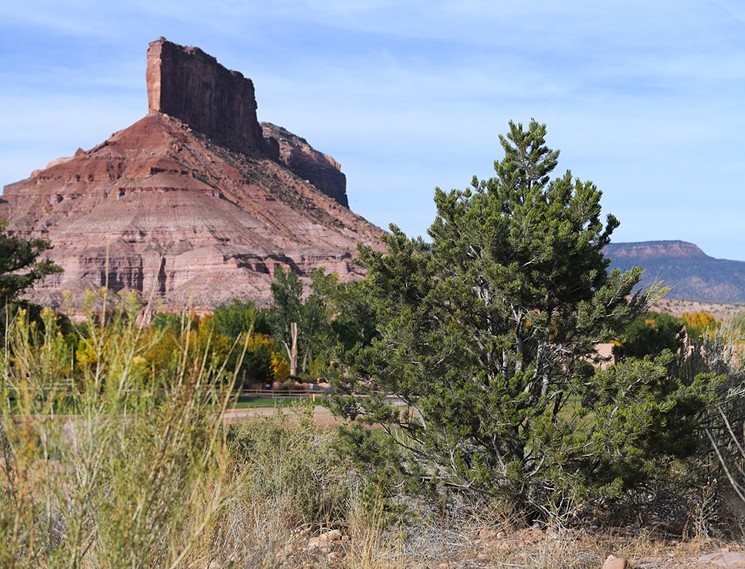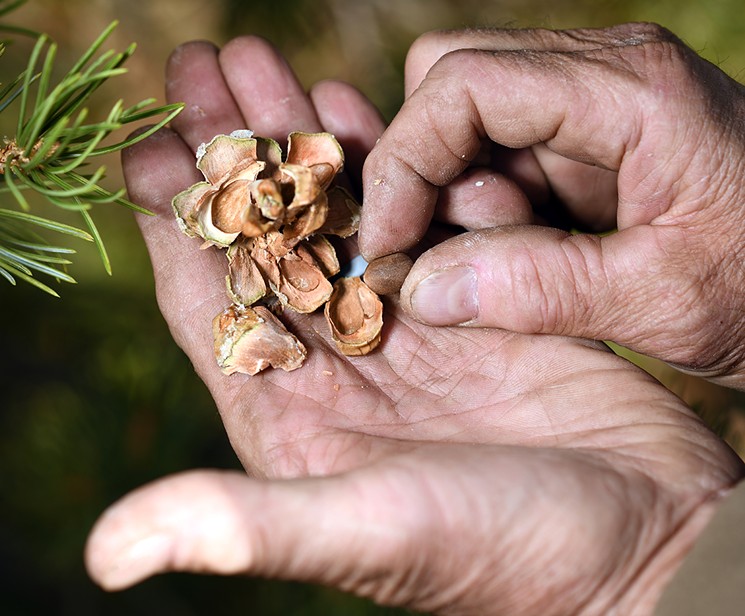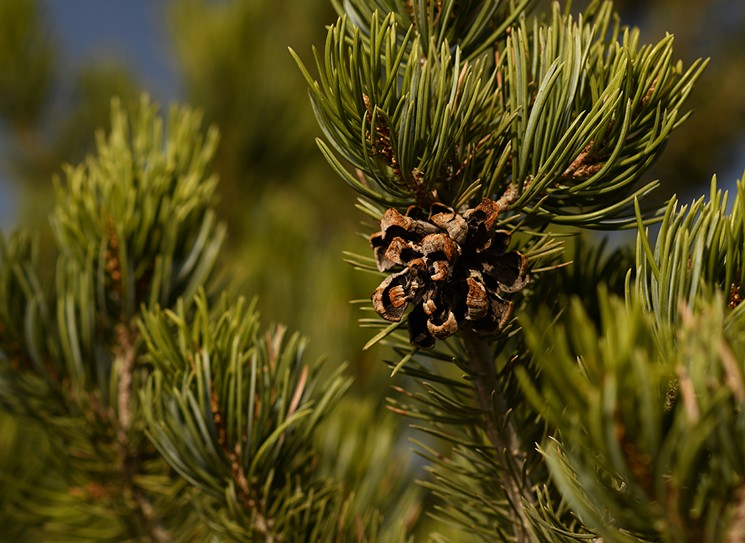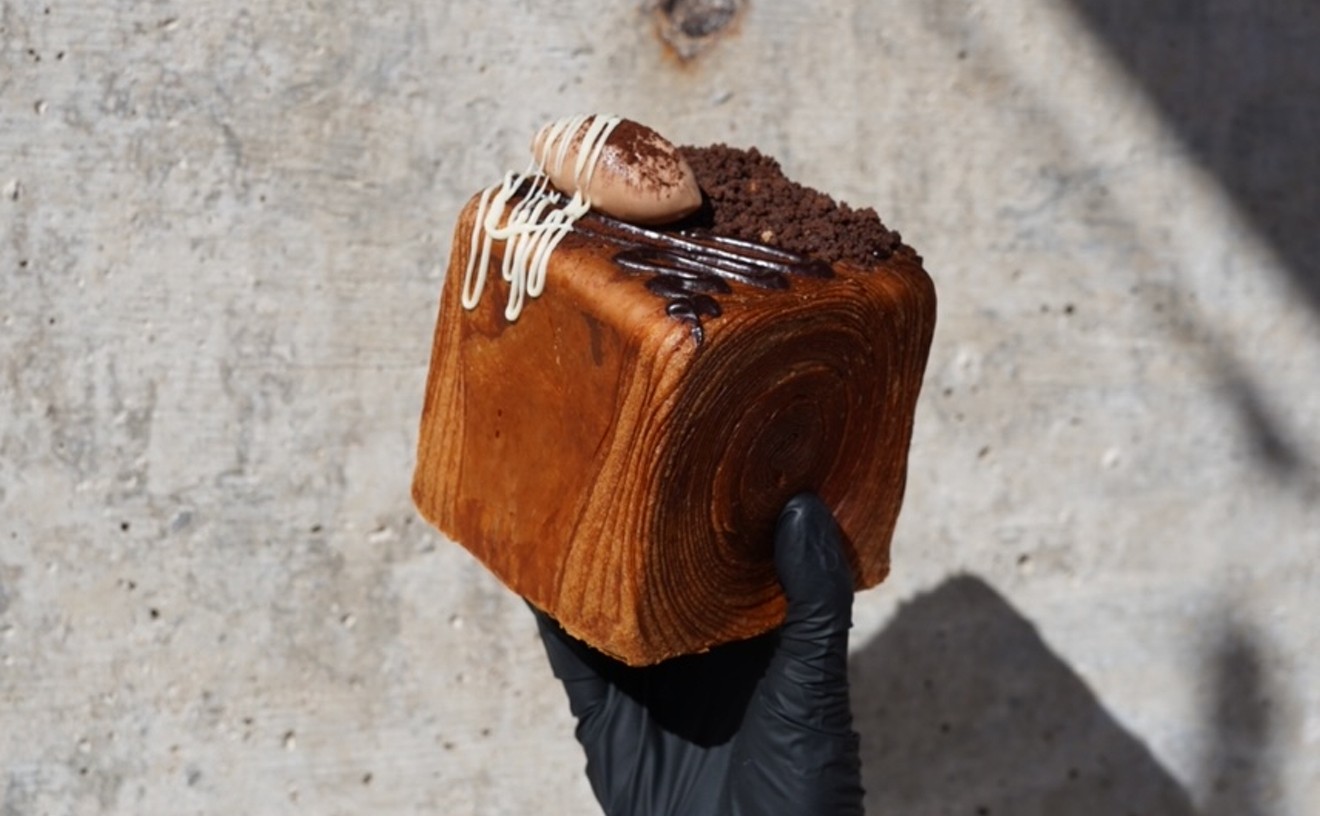Piñon nuts, also known as pine nuts, run an average $23 a pound, compared to $14 for almonds. But getting to that pound isn’t easy: After you’ve found a cone, you must crack it open and make sure the single seed inside is good. Then keep going: It takes roughly 700 piñon nuts to reach a pound.
At least you can forage piñon nuts for free in Colorado. And harvest time is right now.
Roots
The Colorado pinyon ranges beyond this state to parts of Arizona, Utah and New Mexico, which actually claims it as its state tree. One fifth of Colorado’s forests, or five million acres, are woodlands dominated by Colorado pinyon and Rocky Mountain juniper; they typically grow together, and the juniper serves as a nurse to the pinyon. Not that the compact pine needs much help: It reaches a maximum height of twenty feet through slow and steady growth. It’s also drought-tolerant and can last up to 600 years. All pinyon grow in the wild, or close enough. No one cultivates these pines commercially because of the back-breaking work involved in harvesting the nuts and the unreliability of that harvest: Each cone takes nearly two years to produce a seed after an eight-to-ten-year growth period. As a result, 100 percent of the piñon nuts on the market have been foraged.

The Colorado pinyon can be found across the Southwest, and is New Mexico's state tree.
Chad Chisholm
“My family has been in Utah for five generations,” explains Dayer LeBaron. “We learned of pine nuts from the Native Americans. Dating back over 150 years, my Mormon ancestors would trade goods with the Native Americans during the autumn and winter for the holiday nuts. If you didn’t have pine nuts at Thanksgiving, it would be like forgetting to bring the turkey to the table. Likewise for Christmas: No pine nuts, no Santa!”
LeBaron’s ancestors learned not only how tasty the nuts were, but how to forage them. “The best collection spots are still on Native American private grounds, and those locations are passed on throughout the generations,” LeBaron notes. “Lots of tribal communities still make a good business, and in season, the fresh nuts are found with the Native collectors in farmers’ markets and at small street vendors.”
Today, LeBaron’s company, wholesale-pinenuts.com, is the largest collector and distributor of piñon nuts in Nevada. All of the nuts are foraged, though none from reservations. “Very few piñon nuts ever get harvested, for the amount there is,” says LeBaron.
In New Mexico, gathering piñon nuts is a holiday tradition. “My father would take us out every single year to his collection sites in New Mexico, which are the traditional gathering grounds in the high country. Here, he taught us to tell the difference in weight between a good seed and a bad seed,” says Loretta Sandoval, an independent plant breeder.
“I remember how my mom would have to hide the nuts and ration the piñon nuts, we adored them so much. On Christmas, we would get a full bowl just for the day,” she recalls. “Unfortunately, my generation and those that have followed haven’t continued the tradition of the piñon harvest. It’s certainly still available, even with environmental impact.”
Like most natural resources in the West, the pinyon pine has been affected by climate change. “It was horrible about eight years ago. The die-off from the invasive beetle was massive,” says Sandoval. “I thought we would never recover. I was wrong! I have young pinyon that are showing no effects from the disease.”
Scott Dunn, community programs coordinator for Walking Mountains Science Center in Avon, worries about the impact of climate change and disease on Colorado pinyon. “I believe in strong research that indicates warming temperatures and increases in severe drought events in some regions are likely to lead to increased tree mortality and forest die-back, which in turn affect other disturbance processes, such as fire, erosion and insect outbreaks,” he says, citing the work of Craig D. Allen, who did a study on the trees in New Mexico for the U.S. Forest Service.
While the drought-tolerant pinyon is not invincible, it seems to thrive even under extreme duress. Walking Mountain has numerous trees on its property that had productive cones and seed production this season, Dunn says.
Most of Sandoval’s focus is on seed collection and banking. She also tends to juvenile pinyon trees, with plans to reintroduce them to the land around traditional farming communities. And she occasionally hunts for the nuts herself.
“I went foraging by myself last weekend,” she says. “It was grueling work, and I am much older now. When I was eight or ten, it was hard then, but it was an awesome time. I gathered a bunch. Time to start cooking for the holidays.”
Cooking with piñon nuts
Most of the pinyon tree can be used for cooking. Indigenous people steeped the pine needles to brew a tea. The inner bark is edible but far from tasty; they only resorted to it to ward off starvation. However, the outer bark has an extremely aromatic smell that it imparts to food when used as firewood.The nuts are the real delicacy, though. A pound of the nutrient-rich seeds contains about 3,000 calories; the piñons are an excellent source of oleic acid (a monounsaturated fatty acid), vitamin E, calcium, zinc, iron, antioxidants, protein, phosphorus and magnesium.
They also taste good.
“My mother taught me how to make pine nut cookies with salt on top,” Sandoval says. “We had pine cakes, candies, oils; it was weaved into so many facets of our cuisine.”
While many restaurants use piñon nuts, few feature them like Tocabe: An American Indian Eatery. “I am a member of the Osage Nation raised in Denver,” says Ben Jacobs, co-owner of the eatery. “Osage traditionally didn’t use piñon nuts. My restaurant partner, Matt Chandra, and I began including piñon upon opening the restaurant.” Tocabe, which now has two locations, is the only American Indian-owned and -operated restaurant focusing on Native cuisine in metro Denver, and it sources many products from Indigenous cultures and local communities.
“One of my favorite seasonal dishes combines pima 60-day corn with roasted piñon. Both ingredients are culturally significant to certain communities, and they both have been traditionally used for meals over generations,” notes Jacobs. “It’s a hearty dish consisting of coarse-ground corn with wild onions and toasted piñon on top.”
Jacobs doesn’t forage his piñon nuts, but gets them from a variety of sources.
“Piñon has such importance and influence with the Colorado Indian,” he says. “It was essential to reflect the resource and delicacy in our cuisine.”
Do It Yourself
On public lands in Colorado managed by the Bureau of Land Management or the U.S. Forest Service, any individual can harvest up to 25 pounds of pine nuts without a permit. Harvesting any amount over that is considered commercial and requires a permit. Still, 25 pounds equates to $575 of free nuts per person — though they’ll have to collect about 17,500 nuts to get there.Foragers report a bumper crop of piñon nuts this year, and you don’t have to travel far to find the trees. There are 500 in central Denver alone, according to fallingfruit.org, the site of a Boulder-based nonprofit that has the world’s largest collection of information on free edible fruit, nuts and seeds around the globe. It notes that you can find pinyon trees on the Auraria campus, in City Park and at Ruby Hill Park. Central Park (formerly Stapleton) has nearly 200 of them.
Ethan Welty grew up in Washington state, which has longer growing and gathering seasons. “Licorice ferns, berries, mushrooms,” he recalls. “We had an abundance of food. I moved to graduate school in Boulder and began to forage apples from my back yard, and then my neighbors gave me permission after I bought a cider press and needed more.”
He met Caleb Phillips in 2012 at a meeting for Boulder Food Rescue. Both were fascinated by the potential of an urban food forest to help feed the hungry. “At the time, he was an assistant professor in computer science at the University of Colorado,” Welty recalls. “By March 2013, we had our first Falling Fruit platform, and frankly, it hasn’t changed much to this day.”
Initially, fallingfruit.org was loaded with apple trees, reflecting Welty’s passion. Within months, though, dozens of species had been added, including what it labels Colorado Pinon. And like that tree, the site has grown steadily.
“In 2020, we now have more users outside the U.S.” notes Welty. “Nearly 60 percent of the users are international, with a very large community in France. It’s ironic: I’m actually from France, and I think the grapes and stone fruits are extremely popular and cultural for that country.”
The duo deliberately built the platform to focus on plant species in city landscapes, on the edges of private property and at other places that weren’t intended for growing food. Each plant and tree on the site is labeled public or private, so that there’s no confusion about trespassing. To help support the nonprofit, fallingfruit.org has a paid mobile app that works with all mobile devices. “It’s not ideal to have a paid app,” Welty admits. “The website will always remain free, but we need to maintain the platform and data collection.”
Aside from the obvious apples and stone fruits, the site offers a cornucopia of items you can harvest around Denver: wild asparagus (spring), mushrooms (spring and fall, including black and yellow morel, whose growth is reportedly prolific after a wildfire), juniper berries (fall), rose hips, acorns, chestnuts, pecans and chokecherries. But piñon nuts are the prize.
Ready to harvest them yourself? Find a permissible tree, grab a pair of gardening gloves, and look for fallen cones. Crack one open to find the white seed inside. Not all seeds are good; a useful way to find out is to put the seeds in water. Those that float have gone bad.
Some Indigenous people would collect green cones from the tree with a pole, then place them in the sun to mature. Once the cones had turned brown, they would shake the bags to loosen the nuts from the cone. The process took a lot of time but wasn’t as sticky. Other cultures would wait for the cones to fall, then swoop in before animals could.
And there’s one surefire trick for cracking the piñon code: Roast the cones to a certain heat to release perfectly toasted seeds.
Nuts!















